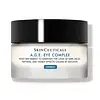What's inside
What's inside
 Key Ingredients
Key Ingredients

 Benefits
Benefits

 Concerns
Concerns

 Ingredients Side-by-side
Ingredients Side-by-side

Water
Skin ConditioningButyrospermum Parkii Butter
Skin ConditioningPropanediol Dicaprylate
EmollientPentylene Glycol
Skin ConditioningC12-16 Alcohols
EmollientPlukenetia Volubilis Seed Oil
EmollientGlycerin
HumectantButylene Glycol
HumectantLactobacillus/Wasabia Japonica Root Ferment Extract
AntioxidantSimmondsia Chinensis Seed Oil
EmollientPerfluorodecalin
Skin ConditioningHydrogenated Lecithin
EmulsifyingPalmitic Acid
EmollientOpuntia Ficus-Indica Seed Oil
EmollientVaccinium Macrocarpon Seed Oil
Skin ConditioningAlbizia Julibrissin Bark Extract
MaskingAdansonia Digitata Pulp Extract
EmollientPueraria Lobata Root Extract
HumectantBiosaccharide Gum-2
Skin ConditioningMilk Protein
Skin ConditioningOpuntia Ficus-Indica Fruit Extract
Skin ConditioningEquisetum Arvense Extract
AstringentCamellia Sinensis Leaf Extract
AntimicrobialPunica Granatum Pericarp Extract
Skin ConditioningCeramide AP
Skin ConditioningPhytosphingosine
Skin ConditioningCholesterol
EmollientCynara Scolymus Leaf Extract
Skin ConditioningTocopherol
AntioxidantDarutoside
Skin ConditioningCeramide EOP
Skin ConditioningCeramide NP
Skin ConditioningLactose
HumectantVitis Vinifera Leaf Water
Skin ConditioningHydroxyethyl Acrylate/Sodium Acryloyldimethyl Taurate Copolymer
Emulsion StabilisingGlyceryl Stearate Citrate
EmollientPropylene Glycol
HumectantPolyperfluoromethylisopropyl Ether
Skin ConditioningSodium Lauroyl Lactylate
EmulsifyingPhenoxyethanol
PreservativePoloxamer 188
EmulsifyingPolysorbate 60
EmulsifyingSorbitan Isostearate
EmulsifyingSodium Benzoate
MaskingXanthan Gum
EmulsifyingLactic Acid
BufferingSodium Dehydroacetate
PreservativePotassium Sorbate
PreservativeCarbomer
Emulsion StabilisingEthylhexylglycerin
Skin ConditioningCitric Acid
BufferingWater, Butyrospermum Parkii Butter, Propanediol Dicaprylate, Pentylene Glycol, C12-16 Alcohols, Plukenetia Volubilis Seed Oil, Glycerin, Butylene Glycol, Lactobacillus/Wasabia Japonica Root Ferment Extract, Simmondsia Chinensis Seed Oil, Perfluorodecalin, Hydrogenated Lecithin, Palmitic Acid, Opuntia Ficus-Indica Seed Oil, Vaccinium Macrocarpon Seed Oil, Albizia Julibrissin Bark Extract, Adansonia Digitata Pulp Extract, Pueraria Lobata Root Extract, Biosaccharide Gum-2, Milk Protein, Opuntia Ficus-Indica Fruit Extract, Equisetum Arvense Extract, Camellia Sinensis Leaf Extract, Punica Granatum Pericarp Extract, Ceramide AP, Phytosphingosine, Cholesterol, Cynara Scolymus Leaf Extract, Tocopherol, Darutoside, Ceramide EOP, Ceramide NP, Lactose, Vitis Vinifera Leaf Water, Hydroxyethyl Acrylate/Sodium Acryloyldimethyl Taurate Copolymer, Glyceryl Stearate Citrate, Propylene Glycol, Polyperfluoromethylisopropyl Ether, Sodium Lauroyl Lactylate, Phenoxyethanol, Poloxamer 188, Polysorbate 60, Sorbitan Isostearate, Sodium Benzoate, Xanthan Gum, Lactic Acid, Sodium Dehydroacetate, Potassium Sorbate, Carbomer, Ethylhexylglycerin, Citric Acid
Water
Skin ConditioningGlycerin
HumectantDimethicone
EmollientIsohexadecane
EmollientParaffin
PerfumingPropylene Glycol
HumectantSilica
AbrasivePolyglyceryl-4 Isostearate
EmulsifyingCetyl PEG/PPG-10/1 Dimethicone
EmulsifyingHexyl Laurate
EmollientNylon-12
Hydroxypropyl Tetrahydropyrantriol
Skin ConditioningMethylsilanol/Silicate Crosspolymer
Skin ConditioningPolyethylene
AbrasiveAscorbyl Glucoside
AntioxidantCaprylic/Capric Triglyceride
MaskingOctyldodecanol
EmollientPhenoxyethanol
PreservativeTocopheryl Acetate
AntioxidantAmmonium Polyacryloyldimethyl Taurate
Emulsion StabilisingPEG-6 Isostearate
EmulsifyingTriethanolamine
BufferingSodium Citrate
BufferingMethylparaben
PreservativeChlorphenesin
AntimicrobialCaffeine
Skin ConditioningTitanium Dioxide
Cosmetic ColorantEthylparaben
PreservativeMenthoxypropanediol
MaskingVaccinium Myrtillus Fruit Extract
Skin ConditioningHesperidin Methyl Chalcone
AntioxidantPentasodium Pentetate
Aluminum Hydroxide
EmollientStearic Acid
CleansingHesperetin Laurate
AntioxidantN-Hydroxysuccinimide
Skin ConditioningDipeptide-2
Skin ConditioningPalmitoyl Tetrapeptide-7
Skin ConditioningPalmitoyl Oligopeptide
CleansingChrysin
Skin ConditioningWater, Glycerin, Dimethicone, Isohexadecane, Paraffin, Propylene Glycol, Silica, Polyglyceryl-4 Isostearate, Cetyl PEG/PPG-10/1 Dimethicone, Hexyl Laurate, Nylon-12, Hydroxypropyl Tetrahydropyrantriol, Methylsilanol/Silicate Crosspolymer, Polyethylene, Ascorbyl Glucoside, Caprylic/Capric Triglyceride, Octyldodecanol, Phenoxyethanol, Tocopheryl Acetate, Ammonium Polyacryloyldimethyl Taurate, PEG-6 Isostearate, Triethanolamine, Sodium Citrate, Methylparaben, Chlorphenesin, Caffeine, Titanium Dioxide, Ethylparaben, Menthoxypropanediol, Vaccinium Myrtillus Fruit Extract, Hesperidin Methyl Chalcone, Pentasodium Pentetate, Aluminum Hydroxide, Stearic Acid, Hesperetin Laurate, N-Hydroxysuccinimide, Dipeptide-2, Palmitoyl Tetrapeptide-7, Palmitoyl Oligopeptide, Chrysin
 Reviews
Reviews

Ingredients Explained
These ingredients are found in both products.
Ingredients higher up in an ingredient list are typically present in a larger amount.
Glycerin is already naturally found in your skin. It helps moisturize and protect your skin.
A study from 2016 found glycerin to be more effective as a humectant than AHAs and hyaluronic acid.
As a humectant, it helps the skin stay hydrated by pulling moisture to your skin. The low molecular weight of glycerin allows it to pull moisture into the deeper layers of your skin.
Hydrated skin improves your skin barrier; Your skin barrier helps protect against irritants and bacteria.
Glycerin has also been found to have antimicrobial and antiviral properties. Due to these properties, glycerin is often used in wound and burn treatments.
In cosmetics, glycerin is usually derived from plants such as soybean or palm. However, it can also be sourced from animals, such as tallow or animal fat.
This ingredient is organic, colorless, odorless, and non-toxic.
Glycerin is the name for this ingredient in American English. British English uses Glycerol/Glycerine.
Learn more about GlycerinPhenoxyethanol is a preservative that has germicide, antimicrobial, and aromatic properties. Studies show that phenoxyethanol can prevent microbial growth. By itself, it has a scent that is similar to that of a rose.
It's often used in formulations along with Caprylyl Glycol to preserve the shelf life of products.
Propylene Glycol is an odorless, colorless liquid. As a humectant, it helps skin retain moisture. It also aids in delivering active ingredients.
Another role of this ingredient is preventing a product from melting or freezing. Propylene glycol also adds antimicrobrial properties to a product, elongating product lifespan.
This ingredient is considered an organic alcohol and commonly added into both cosmetics and foods.
Those with sensitive skin or conditions may develop a rash when using this ingredient.
Learn more about Propylene GlycolWater. It's the most common cosmetic ingredient of all. You'll usually see it at the top of ingredient lists, meaning that it makes up the largest part of the product.
So why is it so popular? Water most often acts as a solvent - this means that it helps dissolve other ingredients into the formulation.
You'll also recognize water as that liquid we all need to stay alive. If you see this, drink a glass of water. Stay hydrated!
Learn more about Water